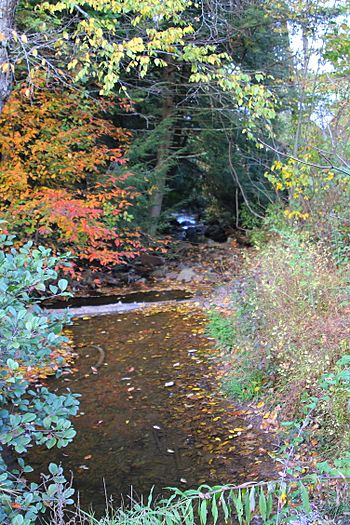Klingermans Run facts for kids
Quick facts for kids Klingermans Run |
|
|---|---|

Klingermans Run looking downstream near its mouth
|
|
| Other name(s) | Klingerman Run |
| Physical characteristics | |
| Main source | Catawissa Mountain in Roaring Creek Township, Columbia County, Pennsylvania 1,600 ft (490 m) |
| River mouth | Catawissa Creek in Beaver Township, Columbia County, Pennsylvania 738 ft (225 m) 40°55′26″N 76°16′03″W / 40.92380°N 76.26762°W |
| Length | 2.4 mi (3.9 km) |
| Basin features | |
| Progression | Catawissa Creek → Susquehanna River → Chesapeake Bay |
| Basin size | 1.78 sq mi (4.6 km2) |
Klingermans Run is a small stream in Columbia County, Pennsylvania, USA. It's also sometimes called Klingerman Run. This stream is about 2.4 miles (3.9 km) long. It flows through two areas: Roaring Creek Township and Beaver Township. The land area that drains into the stream, called its watershed, is about 1.78 square miles (4.6 km2). Klingermans Run is a special place for fish. It's known as a High-Quality Coldwater Fishery and Class A Wild Trout Waters, meaning it's great for wild trout. The ground around the stream has two main types of rock: the Mauch Chunk Formation and the Pocono Formation. The main soils are Leck Kill soil and Hazleton soil.
Contents
Where Klingermans Run Flows
Klingermans Run starts high up on Catawissa Mountain. This mountain is in Roaring Creek Township.
The stream first flows east and a little bit north for over a mile. It then enters Beaver Township. After that, it turns to flow north-northeast for a short distance.
Next, the stream flows northeast for a while before turning north. A short distance later, it joins Catawissa Creek. This meeting point is near Beaver Station Road. Klingermans Run joins Catawissa Creek about 17.08 miles (27.49 km) before Catawissa Creek reaches its own end.
No Tributaries
Klingermans Run does not have any smaller streams or "tributaries" that flow into it.
Water Quality
The water in Klingermans Run has a very low amount of alkalinity. It is only 1 milligram per liter. The pH of the stream's water is 6.0, which means it is slightly acidic. The water is also very soft, with a hardness of only 2 milligrams per liter.
In 1997, the air temperature near the stream was 31 °C (88 °F). At the same time, the water temperature was 13.4 °C (56.1 °F). The water's ability to conduct electricity, called specific conductivity, is 20 umhos.
Land and Rocks Around the Stream
The land near where Klingermans Run ends is about 738 feet (225 m) above sea level. Where the stream begins, its source is much higher. It is about 1,600 feet (490 m) above sea level.
The lower parts of Klingermans Run flow over rocks from the Mauch Chunk Formation. The upper parts of the stream are on rocks from the Pocono Formation. The soil near the lower stream is called Leck Kill soil. The rest of the stream flows over Hazleton soil.
Klingermans Run flows downhill very steeply. It drops about 66.1 meters for every kilometer it travels. The stream itself is about 3.1 metres (10 ft) wide.
Stream's Land Area and History
The watershed of Klingermans Run covers an area of 1.78 square miles (4.6 km2). Most of this land is in Beaver Township. However, a good part of it is also in Roaring Creek Township.
Most of the land in the watershed is covered by forests. A small part of the land is used for farming. The very beginning of the stream is located in Pennsylvania State Game Lands Number 58. The entire upper half of the watershed is also within these game lands.
Klingermans Run is close to another stream called Cranberry Run. Both streams have similar types of rocks and how their land is used. Klingermans Run appears on the United States Geological Survey map for Shumans.
About 24 percent of Klingermans Run's length is within 328 feet (100 m) of a road. In 1990, about 9 people lived in each square kilometer of the watershed.
Some people named W. Klingerman, J. Klingerman, and I. Klingerman used to own land near Klingermans Run. This is how the stream likely got its name.
Stream Life: Fish and More
The Pennsylvania Department of Environmental Protection now calls Klingermans Run a High-Quality Coldwater Fishery. This means it's a very good place for fish that like cold water. In 1997, it was just called a Coldwater Fishery.
The Pennsylvania Fish and Boat Commission says Klingermans Run is Class A Wild Trout Waters. This means wild trout live and reproduce naturally in the stream from its start to its end.
The stream is home to brook trout. These trout are the only type of fish found in Klingermans Run. They can be anywhere from 2.5 centimetres (0.98 in) to 22.4 centimetres (8.8 in) long. The total weight of trout in the stream is about 33.90 kilograms per hectare.
In 1997, a report said that Klingermans Run was not a very good place for fishing.

